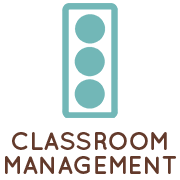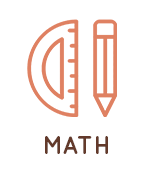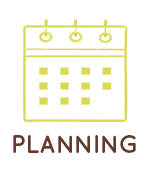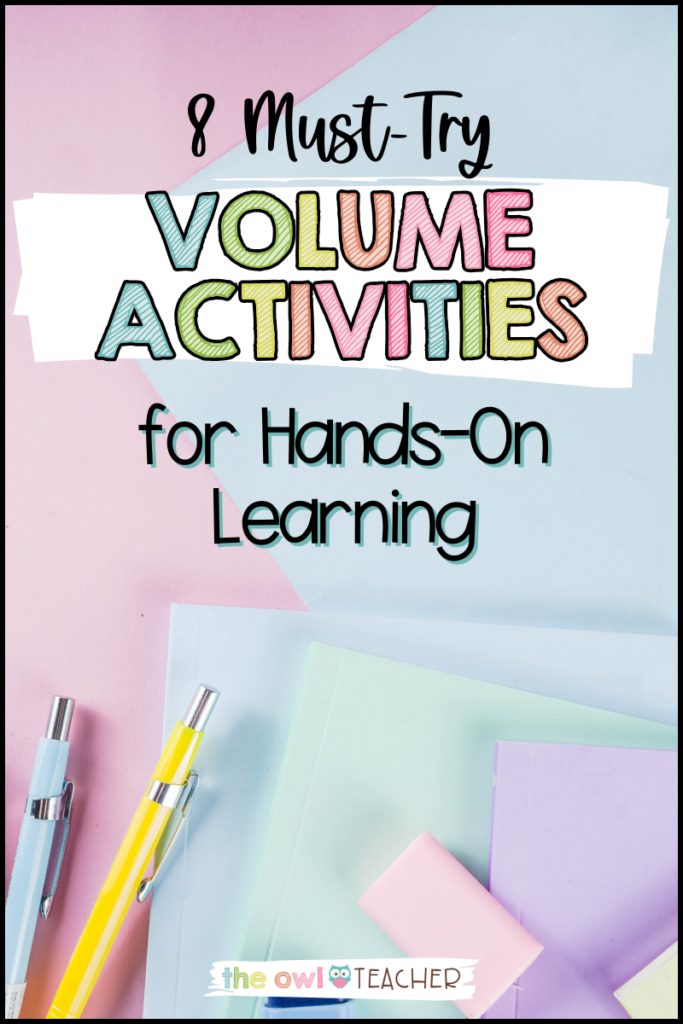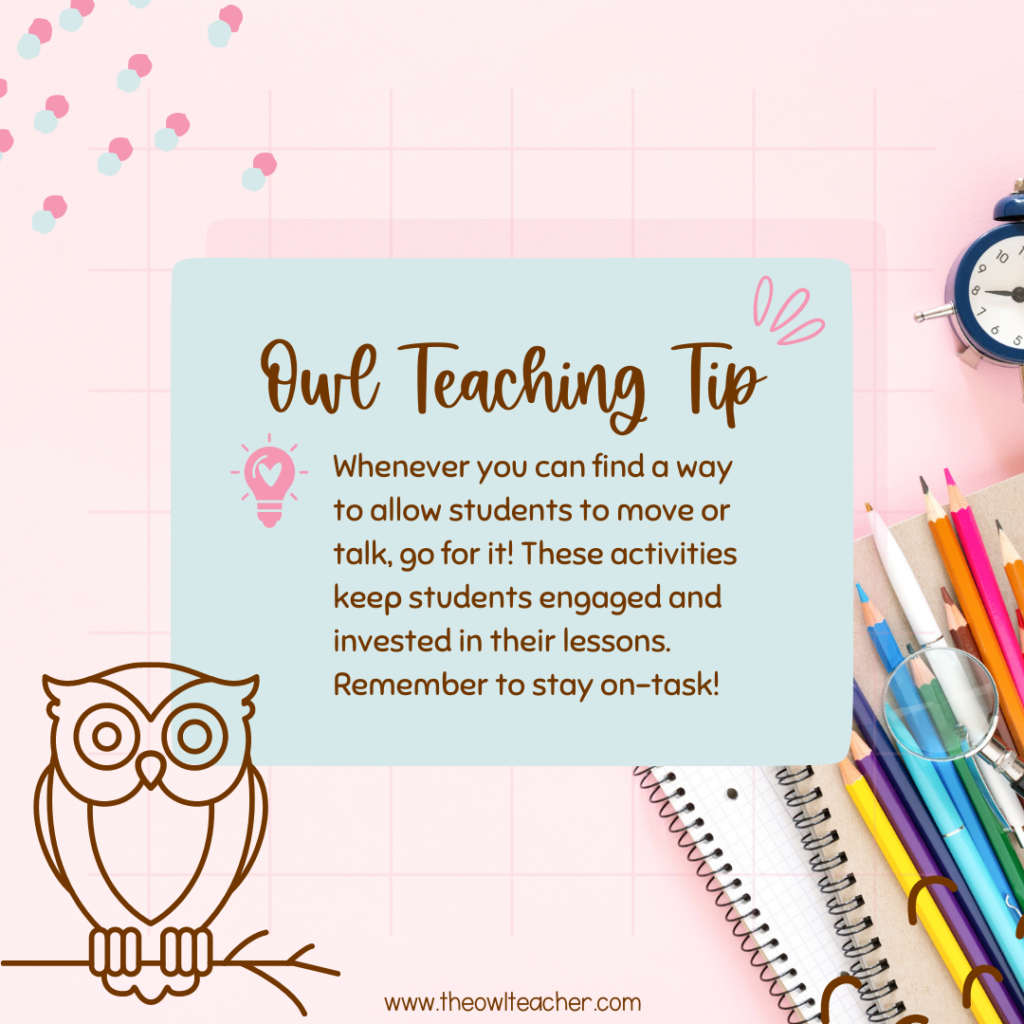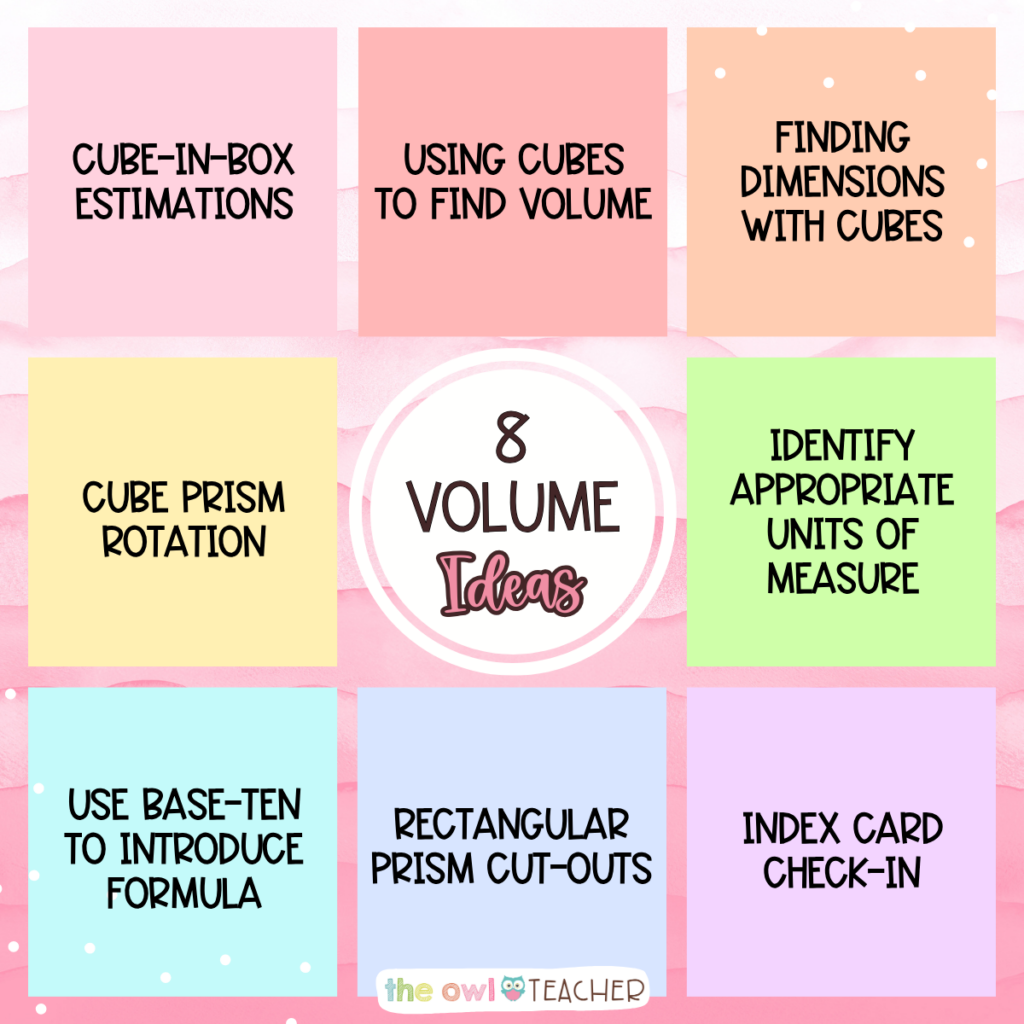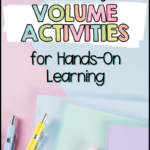
When it comes to complicated concepts in your upper elementary math classroom, volume is up there as one of the Great Intimidators. There’s no doubt that it’s incredibly important for your kiddos to develop a strong understanding of volume, but it’s not always easy!
To satisfy Common Core standards, students in fifth grade should be able to understand the concept of volume measurement, be able to measure volume by counting cubes as well as using a formula, comprehend that volume is additive, and apply their knowledge to real-world problems. Whew! That’s quite the list, don’t you think? And that’s not to mention everything else your poor fifth graders have going on!
Thankfully, for every question volume poses, there’s an answer. Even when it comes to giving your students the information they need in the easiest, stress-free way possible, there’s an answer for that, too! When you employ hands-on learning in your math classroom, you make abstract concepts tangible and easier to understand, which improves retention as well as application skills. Besides, if your kiddos are having fun, then you’re tricking them into learning, too! 😉
The concept of volume in itself is significant, too. Volume prepares students for complex concepts in higher grades, and is especially crucial for geometry and spatial reasoning. Building a strong foundation for advanced math is sure to set students up for success throughout their scholarly careers. In addition, volume is a concept found often in real-world scenarios—there’s no question of “when are we going to use this?” here!
But I’m not here to tell you why you must teach volume to your fifth grade math students; the CCSS already have that covered. Instead, let’s take a look at eight hands-on activities for teaching volume that are sure to engage your math students and provide them with a solid understanding of the tricky concept.
8 Activities to Explore Volume in Math
Volume isn’t just a math concept, either; it has its place in science as well, specifically with liquid volume. Often, students look at liquid volume and the volume of prisms as two separate concepts, but “volume” in and of itself is simply referring to the amount of space in a container. In science, we use liquid to fill that space, while in math, we use formulas and calculations to find that space.
While these activities focus on the mathematical side of volume, there is still merit to exploring the differences between the concept from a cross-curricular standpoint. Besides. if you take a look at both math and science, you’re effectively creating an integrated curriculum! We love sneaking in those ways to save time while covering all the necessary curriculum.
Now, let’s take a look at the first activity in our series!
1. Making Connections with Cubes
To help distinguish between volume in science and math, consider having a lesson that reviews liquid volume and then introduce volume of rectangular prisms. Once you’ve established the idea, it’s time to move onto the hands-on (read: fun) part!
Ahead of time, prepare a set of cubes packed into a box. If you can, use cubes that make a real-life connection, such as sugar cubes, toddler blocks, snap cubes, or so on. Pack them into a box of whichever size you’d like, keeping in mind that students should make estimates on how many cubes are packed into the box–you probably shouldn’t do too many!
As a class, brainstorm ways that students can find the number of cubes in the box, taking care to use math language as you go—remind your kiddos that you’re finding the volume of the box via the cubes! Once you feel satisfied with the estimates, count the cubes in the box with your class to find the real volume. Then, take it a step further: ask your students to come up with ways they can find the volume of the box without having to count every single cube.
To engage those critical thinking skills, ask students why the cubes were packed tightly into the box without any gaps. Whenever you have the opportunity for inquiry-based learning, you should take it!
2. Cubing Inquiry and Exploration
For this activity, you’ll want to pair students up. Take advantage of your kiddos’ social natures to sneak in some learning!
Each pair should receive around 50 cubes, with 24 of those cubes representing centimeters and the other 26 representing inches. Then, give students a variety of boxes and ask them to find the volume by using nothing except the cubes and their brains.
This is an excellent opportunity to observe your classroom and check for understanding. Are students only using one size of cube? Is anyone leaving gapes between their cubes? Use these situations to guide students in the right direction toward understanding volume. Of course, be sure to scaffold your kiddos rather than rescuing them!
3. Explain and Understand with Dimensions
Since volume is a prominent concept in both science and math, take the time to ensure your students understand what is meant by “the volume of a solid figure” and how they can calculate that volume. In order to reinforce this idea, make this abstract concept tangible!
Provide students with 12 cubes to create their own rectangular prisms. Discuss the variety of dimensions created and check to make sure kiddos are finding every dimension; visualizing those three-dimensional shapes can be tricky at first.
This is a great opportunity for informal assessments, too, as well as intervention time if needed. You want your fifth grade students to build a strong foundation with volume in order to succeed with more complicated math concepts later on!
4. Quick Check-In
At this point in the process, you’ll want to check in with your kiddos to see where they’re at. Consider setting up cubes on each student’s desk (or cluster of desks) for groups to rotate through. At each station, students should use the set-up cubes to find the volume of the rectangular prism in cubic units.
Alternatively, you can create a variety of rectangular prisms using the cubes and take pictures of each. Then, you would display the pictures of the different-sized prisms on each desk or grouping. By using pictures, students would have to apply critical thinking skills to find the total cubic units—they wouldn’t be able to simply count every cube.
5. Appropriate Units of Measure
More real-world application? You got it! For this activity, provide students with six boxes of varying sizes labeled A through F. In pairs or groups, have students think-pair-share to determine which measuring tool (ruler, yardstick, meter stick) would be the most appropriate to measure each box and find its volume.
Then, provide students with a ruler (in3, cm3), a yardstick (ft3, yd3) and a meter stick (m3). As groups and then as a class, discuss the use of appropriate tools, introducing real-life scenarios; for instance, you wouldn’t want to measure the volume of a swimming pool with only a measly ruler, right?
Of course, to save space and money, you can have students rotate their boxes with each group receiving one at a time rather than creating six boxes for every group. It’s totally up to you!
6. Transitioning to the Formula
Ultimately, there comes a time in every lesson where students must transition from counting to using a formula. When your kiddos are good and ready, it’s time to set aside the counting cubes and break out the volume algorithms!
To make the formula more concrete, consider pulling out the base-ten blocks—they aren’t just for lower elementary! To use these manipulatives effectively, have students build a rectangular prism with a particular volume, such as 36 inches, and help them count the sides just as they did long ago with arrays and area. In fact, this is a great time to review perimeter, too!
While students are exploring with the base-ten blocks, take this opportunity to remind kiddos that the same numbers can represent different rectangular prisms. For instance, a shape with the formula 2 x 2 x 3 is an entirely different shape from one with the dimensions of 2 x 3 x 2 despite both shapes being two units on two sides and 3 units on another.
7. Practicing the Formula
Beyond boring old worksheets, one engaging way to practice the volume formula is to break out the magazines. Let me explain: have students cut out pictures in magazines (or online) of rectangular prisms. It’s fine to use a few images of shapes with dimensions already given, but take care to avoid practice sheets—we want to use real-world items!
Once everyone has gathered several images of rectangular prisms, have students write numbers for all the sides of the prisms and trade sheets with a partner. Then, kiddos should solve for the volume of each shape on their newly-traded sheets. If there’s enough time, have students trade back and check one another’s work.
8. Formula Check-In
For this activity, come up with a set of volume problems to review with your math classroom. Then, for every problem, write the answer on an index card, making sure that you have enough for every student to receive one.
Once the index cards are prepared, provide each student with an answer card. Then, provide your classroom with one example problem at a time to either solve on scrap paper or on personal whiteboards. Whichever student has the matching answer to that problem on their index card should raise it into the air to everyone to see and verify. Repeat through your entire set of prepared problems.
Follow-Up Ideas
For further exploration of volume and its many uses in the math world, have students construct their own rectangular prisms using construction paper or grid paper. This is a great way to bring in other measurement skills, too, that may go underutilized. In fact, you could even instruct students to create as many prisms as possible when given a specific volume.
To practice estimation, play the blind bag game! Place a mystery block inside a brown paper bag (or other opaque bag) and have students attempt to guess the volume of the block inside. The catch is that they can only ask yes or no questions! After every student has asked the questions they want, then you may allow guesses. If you’d like, this activity can also be done in groups of three or four.
Next, you can have students observe patterns in volume and even create their own. Start with a simple rectangular prism or, in this case, a cube with dimensions of 1 cm x 1 cm x 1 cm. Then, have students increase one dimension (or more) by a specific amount with each iteration. Together as a class, discuss what patterns they notice.
Finally, if your kiddos are starving after all this hard work with volume, introduce some tasty treats! Create models of rectangular prisms using marshmallows with pipe cleaners, crispy rice treats, chocolate bars, cheese blocks, or anything rectangular you can scrounge up.
Ultimately, when you’re engaging your fifth grade math students, they’re learning at their best. Tricky abstract concepts like volume can be made easier when you bring them down to a concrete level! Hands-on learning is always a win in any math classroom, as your students will no doubt attest.
If you’re interested in more engaging math lessons, check out my math workshop unit covering volume, mass, data, and graphing!
What ideas do you use to teach volume in your math classroom? Which ideas here are you going to try first? I’d love to hear all about it. Make sure to share this post with a fellow math teacher pal to share the love!


